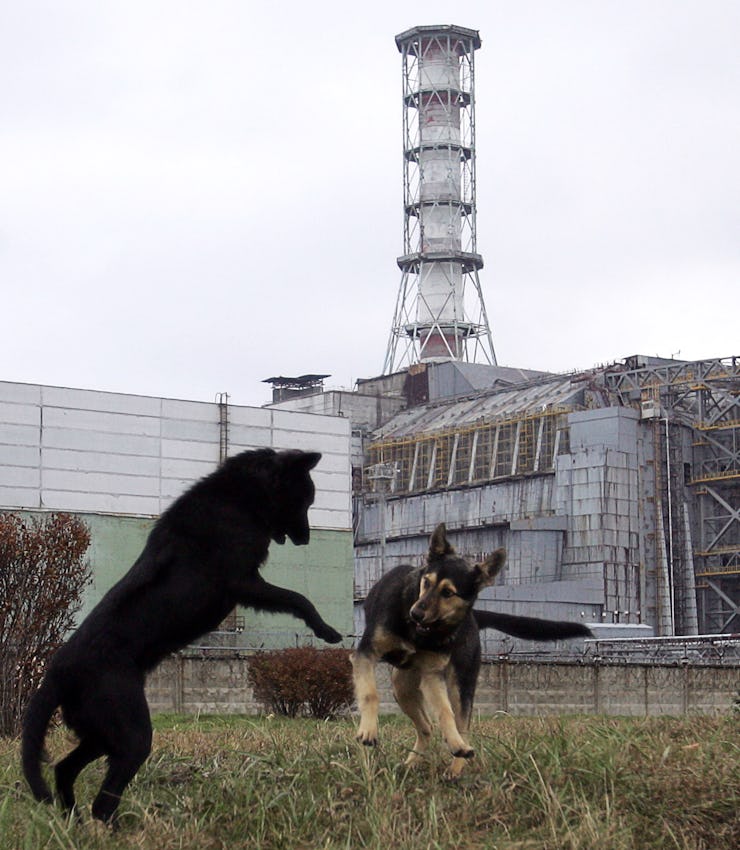What the Dogs of Chernobyl Could Tell Us About Living on Mars
A new study shows the long-term effects of living in an irradiated environment.

As NASA plans to return to the Moon, and eventually send astronauts to Mars, mission planners will have to grapple with a fact of life in deep space beyond the protective ward of Earth’s geomagnetic field — constant bombardment by cosmic radiation. Learning how humans will respond to chronically elevated but not immediately lethal radiation environments is a necessity for scientists hoping to protect or heal future astronauts from their passage through the cosmic radiation bath on their way to and from the Red Planet.
“The real challenge for NASA and SpaceX and others is that we really can not easily simulate the space radiation environment here on Earth,” the University of South Carolina evolutionary geneticist Timothy Mousseau tells Inverse.
But Mousseau is one of the authors of a new study published Friday in the journal Science Advances that takes advantage of one of the few places on Earth that gets close to simulating the space radiation environment: The Chernobyl exclusion zone, the 19-mile wide area that was evacuated in the aftermath of the 1986 explosion of a nuclear reactor at the Chernobyl power plant in what is today’s Ukraine.
And it’s not just the environment, but the population that lives there: The wild dogs of Chernobyl, the descendants of pets that were left behind when people were forced to evacuate in the wake of the nuclear disaster 37 years ago.
“We're very much hoping that anything we can learn about how these dogs have responded to the Chernobyl environment might have some use for human health studies,” Mousseau says. “[Dogs] are a fantastic proxy. They get many of the same diseases we get, many of the same cancers that we get.”
Irradiated dogs
The destroyed reactor before the tomb was put over it.
The Chernobyl Dog Research Initiative, a collaboration between Mousseau, Elaine Ostrander, a cancer geneticist with the National Human Genome Research Institute and the National Institutes of Health and their colleagues across multiple institutions, took blood samples from 302 dogs living in the Chernobyl exclusion zone between 2017 and 2019. They then performed genetic analyses of the dogs to determine their relations to each other and to dog populations in the areas surrounding the exclusion zone.
“The main message from this paper, really is that these dogs, they stay rather local,” Mousseau says. “Also, there hasn't been a lot of immigration into these populations for the past 30-odd years, and they've kind of existed mostly in isolation.”
The study is the first in a series that will look at how these dogs may have been altered by the background radiation levels across 15 or so generations, according to Mousseau, establishing the researchers’ baseline understanding of the population.
“We can then start to look at any kind of signatures, the kinds of patterns, what Elaine likes to call genetic scarring, that might be related to the exposures that these populations have experienced,” he says.
Understanding radiation’s effects
Mousseau’s career has focused on biological responses to radiation, primarily looking at plants, insects and rodents in the areas around Chernobyl and Fukushima, the latter the site of a nuclear reactor disaster in Japan in 2011.
But in 2017, Mousseau was put in contact with the nonprofit Clean Futures Fund, which was running a veterinary clinic to spay and neuter the wild dog population in the Chernobyl exclusion zone.
“I called them up realizing that this was an incredible opportunity to track this large population of mammals, large mammals, not so different from ourselves who were living in this environment,” he says.
Mousseau started taking DNA samples from the dogs before he even knew what he would do with them.
“I searched around and started calling up folks involved in dog genomics research and came upon Elaine Ostrander, who it turns out is a cancer geneticist, but then also is one of the world's leading authorities on dog evolution and dog genomics in general,” he says. The two started the collaboration that would become the Chernobyl Dog Research Initiative, beginning by sponsoring a Ph.D. student at the University of South Carolina, Gabriella Spatola, to begin work in Ostrander’s lab at NIH. Spatola is the lead author of the new study.
“She got the ball rolling,” Mousseau says.
What’s next
Stray dogs near the reactor in 2018.
The initiative is an ongoing project, according to Mousseau, and two subsequent studies are already in the works, with the next likely to publish in the next few months.
”The next step will be then to look at the gene expression and genetic changes that might exist, recorded in the genomes of these Chernobyl dogs related to mechanisms of adaptation to ionizing radiation particularly,” he says. “That is actually the next step where we're actually in the process of doing whole genome sequencing for these animals.”
The researchers are also tracking the health of about 30 Chernobyl dogs that were removed from the area as puppies to be raised in the US.
“We're tracking their health through their lifetimes,” Mousseau says. “Hopefully, that'll give us some other clues as to what the negative consequences might be of the genetic load that they've experienced.”
In the long term, Mousseau sees a real opportunity to conduct valuable research on the effects of radiation near Chernobyl, perhaps even setting up a laboratory inside the confinement facility built around the still radioactive reactor at the Chernobyl power plant.
“Maybe not with animals so much,” he says, “but certainly with plants and cell cultures and things like that.”